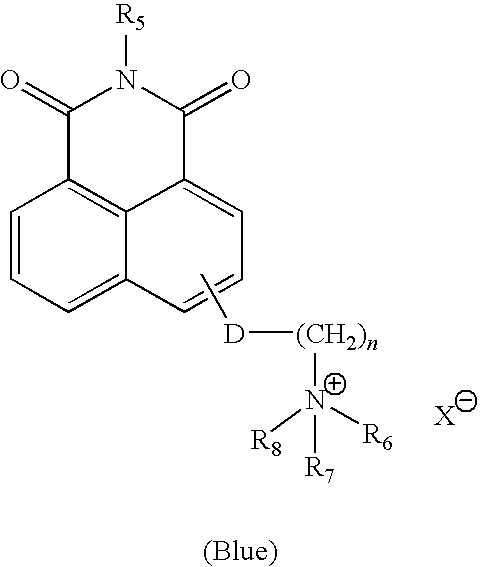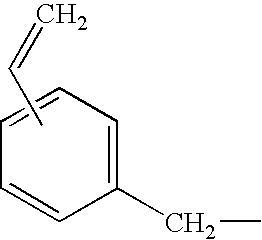Fluorescent monomers and tagged treatment polymers containing same for use in industrial water systems
a technology of industrial water systems and fluorescent monomers, which is applied in the field of fluorescent monomers and tagged treatment polymers, can solve the problems of scale formation, unfavorable events, and progressively deteriorating water quality in the system
- Summary
- Abstract
- Description
- Claims
- Application Information
AI Technical Summary
Problems solved by technology
Method used
Image
Examples
example 1
Monomer Example 1
[0200]
Preparation of N-allyl-4-(2-N′,N′-dimethylaminoethoxy)naphthalimide, methyl sulfate quaternary salt (4-NADMAEN-MSQ)
Step One: Synthesis of 4-chloro-N-allyl-naphthalimide(I)
[0201]A 100 ml round bottom flask was charged with 4-chloro-1,8-naphthalic anhydride (5.98 g, 25.7 mmol), allyl amine (1.522 g, 26.7 mmol), and glacial acetic acid (50 ml). The contents were refluxed for 5 hours. Upon cooling, water was added followed by neutralization with 50% sodium hydroxide solution. The tan precipitate was collected by filtration, washed, and dried.
Step Two: Synthesis of N-allyl-4-(N′,N′-dimethylaminoethoxy)naphthalimide (II)
[0202]A 300 ml Parr reactor was charged with 4-chloro-N-allyl-naphthalimide(I) (2 g, 7.38 mmol), N,N-dimethylaminoethanol (20 g, 0.224 mole), and potassium hydroxide (2 g, 35.7 mmol). The reactor was purged with N2 for 10 minutes, sealed and then heated to 150° C. for 4 hours. Upon cooling, the volatiles were stripped and a crude orange / yellow solid ...
polymer example 1
Preparation of 0.04 Mole % 4-NADMAEN-MSQ / 49.98 mole % Acrylic Acid / 49.98 mole % Acrylamide
[0204]A suitable reactor was charged with deionized water (133.7 g), and 4-NADMAEN-MSQ (prepared according to Monomer Example 1, 0.458 g, 1.02 mmol) and heated to 65° C. with stirring (750 rpm). At this temperature, initiator solution 1 (3.50 g ammonium persulfate in 19.59 g of deionized water), and initiator solution 2 (10.48 g sodium metabisulfite in 30.30 g of deionized water) were added separately at a constant flow rate over a period of 3.25 hours. Five minutes after initiator feed had started, a monomer solution consisting of deionized water (13.57 g), acrylic acid (92.48 g, 1.28 mole), 48.7% acrylamide (186.61 g, 1.28 mole), and 50% sodium hydroxide (42.3 g, 0.529 mole) was added separately at a constant flow rate over a period of 3 hours. After monomer and initiator feeding was complete, the reaction was held at temperature for an additional 30 minutes. The product had a molecular weigh...
use example 1
Method of Use Example 1
Stability and Performance Testing
[0205]The fluorescence properties (excitation and emission maxima) of a polymer made in Polymer Example 1 are given in Table I. Excitation maxima are all greater than 370 nm. The fluorescence of the polymer remained invariant over a pH range of approximately 2-12.
[0206]Another important feature of these polymers is the stability of the fluorescence in the presence of oxidizing biocides. The oxidizing biocide stability test was performed in the following manner. Solutions of simulated water were prepared with the desired levels of cations and anions at the desired pH. For these experiments the simulated cooling water contained 360 ppm Ca (as CaCO3), 200 ppm Mg (as CaCO3), 300 ppm alkalinity (as CaCO3) and 15 ppm of a stable phosphonate, to stabilize the water and prevent CaCO3 precipitation. The water was then adjusted to the desired pH with HCl or NaOH. Tests were performed at pH 7 and 9. A series of three amber bottles were la...
PUM
| Property | Measurement | Unit |
|---|---|---|
| viscosities | aaaaa | aaaaa |
| time | aaaaa | aaaaa |
| temperature | aaaaa | aaaaa |
Abstract
Description
Claims
Application Information
 Login to View More
Login to View More - R&D
- Intellectual Property
- Life Sciences
- Materials
- Tech Scout
- Unparalleled Data Quality
- Higher Quality Content
- 60% Fewer Hallucinations
Browse by: Latest US Patents, China's latest patents, Technical Efficacy Thesaurus, Application Domain, Technology Topic, Popular Technical Reports.
© 2025 PatSnap. All rights reserved.Legal|Privacy policy|Modern Slavery Act Transparency Statement|Sitemap|About US| Contact US: help@patsnap.com



